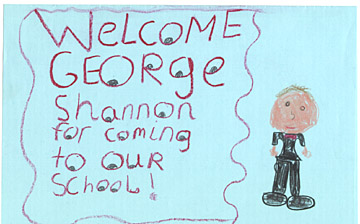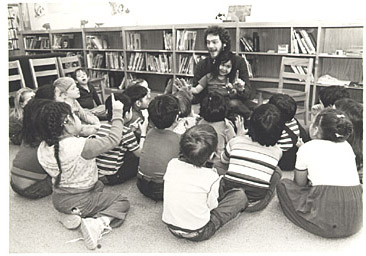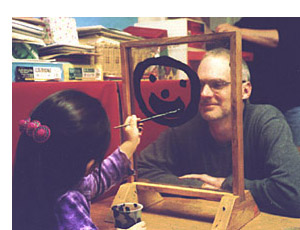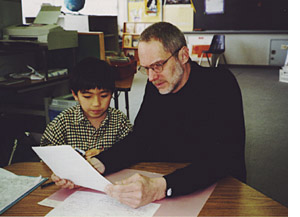 |
||
A former children's librarian and professional storyteller, George Shannon has worked as a freelance writer and lecturer for over 25 years. Conferences, workshops, and author visits to schools have taken him from Japan to Kuwait, Thailand to the Arctic Circle.
Nurturing
creative writing does far more than help students improve their communication
skills and pleasures in reading. It widens their lives on a daily basis
as they come to see what makes us each unique and yet alike. Program NotesWriting,
to me, is like working a large jigsaw puzzle. The pieces must come first,
and then I can begin seeing how they fit together and what still needs
to be found. This puzzle-making continues through several rewrites which
are simply part of the process like trying different puzzle pieces to
find the right fit. By focusing on this process of writing rather than
the end product, students and I explore the ways writing begins long
before pen touches paper. A vital part of this discussion is our exploration
of the I have found that 20-30 minutes is a good length for K-1 programs. Second and third graders can go 30-45 minutes. Fourth through sixth grade students can easily make an hour disappear. Older students, naturally, have more questions and are more ready to explore writing questions in depth. I strive to help students realize they know more about writing than they think they do and invite questions, especially from the upper grades.
An empty library floor is always an excellent location for programs. If groups need to be larger, a clip-on microphone is usually helpful to insure that everyone can hear. About ordering books from publishersPlease feel free to contact me if you have additional questions. Email: gwbshannon@gmail.com |
||

 Presentations
tailored to each age group’s attention span, points of reference,
and amount of writing experience provide a strong sense of immediacy
and interaction.
Presentations
tailored to each age group’s attention span, points of reference,
and amount of writing experience provide a strong sense of immediacy
and interaction. many ways ideas can be found in our daily lives and interests. We also
explore what a story is, how narratives work, and how human emotions
are the heart of all stories. Just as the picture on the puzzle box
helps guide us in solving the jigsaw puzzle, having a clear idea of
what a story is guides us in solving our writing puzzle.
many ways ideas can be found in our daily lives and interests. We also
explore what a story is, how narratives work, and how human emotions
are the heart of all stories. Just as the picture on the puzzle box
helps guide us in solving the jigsaw puzzle, having a clear idea of
what a story is guides us in solving our writing puzzle. Smaller
groups are always the ideal because they allow more interaction. But
larger groups are also manageable. In putting larger groups together
I recommend having students group in similar ages and attention spans.
This allows me to more effectively reach the students by tailoring my
examples, metaphors and similes to their age and interests. If needed,
I can also do separate brief visits to the kindergarten rooms so that
both morning and afternoon sessions can be a part of the day. This also
allows us to stretch the programs a bit longer for first and second
graders.
Smaller
groups are always the ideal because they allow more interaction. But
larger groups are also manageable. In putting larger groups together
I recommend having students group in similar ages and attention spans.
This allows me to more effectively reach the students by tailoring my
examples, metaphors and similes to their age and interests. If needed,
I can also do separate brief visits to the kindergarten rooms so that
both morning and afternoon sessions can be a part of the day. This also
allows us to stretch the programs a bit longer for first and second
graders.